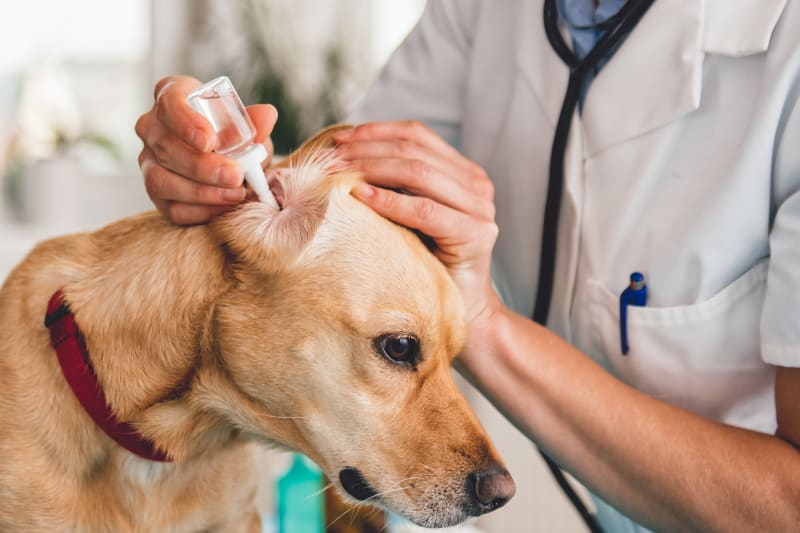Table of Contents
Ear infections are a common issue for pets, particularly for dogs and cats with floppy ears or those that spend a lot of time in the water. Understanding how to treat pet ear infections is crucial for ensuring your pet’s health and comfort. This guide covers the symptoms, treatments, and preventive measures for ear infections in pets.

1. Identifying the Symptoms of Pet Ear Infections
Recognizing the signs of an ear infection early can help you provide prompt treatment and prevent complications. Common symptoms include:
- Scratching at the ear: Pets may frequently scratch or paw at their ears.
- Head shaking: Constant shaking of the head is a common sign.
- Odor: A strong, unpleasant odor from the ear indicates an infection.
- Discharge: Presence of brown, yellow, or bloody discharge in the ear.
- Redness and swelling: The ear canal may appear red and swollen.
- Pain: Your pet may show signs of pain when the ear is touched.
2. Visit the Veterinarian
If you suspect your pet has an ear infection, it is essential to visit the veterinarian for a proper diagnosis and treatment plan. The vet will examine the ear canal and may take a sample of the discharge to identify the cause of the infection.
3. Cleaning the Ear
Cleaning your pet’s ear is an important step in treating an ear infection. Use a vet-recommended ear cleaner and follow these steps:
- Preparation: Gather all necessary supplies, including the ear cleaner, cotton balls, and treats to reward your pet.
- Application: Gently lift your pet’s ear flap and apply the ear cleaner into the ear canal.
- Massage: Gently massage the base of the ear for about 30 seconds to help loosen debris and wax.
- Wipe: Use a cotton ball to wipe away the debris and excess cleaner. Avoid using cotton swabs, as they can push debris further into the ear canal.
4. Medication
Your veterinarian may prescribe medications such as antibiotics or antifungal ear drops to treat the infection. Follow the vet’s instructions carefully:
- Dosage: Administer the prescribed dosage as directed.
- Duration: Complete the full course of medication, even if symptoms improve before finishing the medication.
- Application: Ensure the medication reaches deep into the ear canal for effective treatment.
5. Monitoring Progress
Monitor your pet’s progress during the treatment period. Look for improvements in symptoms such as reduced scratching, less head shaking, and a decrease in discharge and odor. If symptoms persist or worsen, contact your veterinarian.
6. Preventing Future Infections
Preventing ear infections is crucial to maintaining your pet’s ear health. Here are some tips to help prevent future infections:
- Regular Cleaning: Clean your pet’s ears regularly using a vet-recommended ear cleaner.
- Dry Ears: Keep your pet’s ears dry, especially after swimming or bathing.
- Avoid Irritants: Avoid exposing your pet’s ears to irritants such as dust, pollen, and chemicals.
- Healthy Diet: Ensure your pet has a balanced diet to support their immune system.
7. Understanding the Causes
Understanding the common causes of ear infections can help in prevention and treatment. Common causes include:
- Bacteria and Yeast: These are the most common causes of ear infections in pets.
- Allergies: Pets with allergies are more prone to ear infections due to inflammation and excess moisture in the ears.
- Ear Mites: Tiny parasites that can cause intense itching and discomfort.
- Foreign Bodies: Objects like grass seeds can get stuck in the ear canal, leading to infection.
8. Breeds Prone to Ear Infections
Some breeds are more prone to ear infections due to their ear structure. Breeds with floppy ears or excessive hair in the ear canal are at higher risk:
- Dogs: Cocker Spaniels, Basset Hounds, Poodles, and Golden Retrievers.
- Cats: Persian and Himalayan cats with narrow ear canals or excessive ear hair.
9. Home Remedies and When to Avoid Them
While some home remedies can provide temporary relief, they are not a substitute for veterinary care. Use caution with home remedies, and avoid using them if your pet’s ear is severely infected or painful:
- Vinegar Solution: A mixture of equal parts white vinegar and water can help clean the ears, but should be used with caution.
- Coconut Oil: Applying a small amount of coconut oil can soothe irritated skin, but avoid using if the ear is infected.
Always consult your veterinarian before trying any home remedies.
10. Follow-Up Care
Follow-up care is essential to ensure the infection is fully resolved and to prevent recurrence. Schedule a follow-up appointment with your veterinarian to check your pet’s ear health and discuss ongoing care.
Additional Resources on How to Treat Pet Ear Infections
For more detailed information and support, check out these trusted resources:
Understanding how to treat pet ear infections is crucial for your pet’s health and comfort. By recognizing the symptoms, providing proper treatment, and taking preventive measures, you can help ensure your pet’s ears remain healthy. For more resources on pet care, visit our Pet Care section.
FAQs
What are the common symptoms of ear infections in pets?
Common symptoms include scratching at the ear, head shaking, foul odor, discharge, redness, swelling, and pain when the ear is touched.
How often should I clean my pet’s ears?
Clean your pet’s ears regularly, typically once a week, or as recommended by your veterinarian. Always use a vet-approved ear cleaner.
Can I use human ear drops for my pet’s ear infection?
No, you should not use human ear drops on pets. Always use medications prescribed by your veterinarian.
Are certain breeds more prone to ear infections?
Yes, breeds with floppy ears or excessive hair in the ear canal, such as Cocker Spaniels and Basset Hounds, are more prone to ear infections.
What can I do to prevent ear infections in my pet?
Regularly clean your pet’s ears, keep them dry, avoid irritants, and provide a balanced diet to support their immune system.
When should I see a veterinarian for my pet’s ear infection?
If you notice any symptoms of an ear infection, such as discharge, odor, redness, or swelling, it’s important to see a veterinarian promptly for a proper diagnosis and treatment plan.
Conclusion
Understanding how to treat pet ear infections is essential for ensuring your furry friend remains healthy and comfortable. By recognizing symptoms early, providing appropriate treatment, and taking preventive measures, you can help keep your pet’s ears in optimal condition.
Get LIFETIME ACCESS to “My Private Prompt Library”: https://bit.ly/MTSPromptsLibrary
Looking for a custom GPT? or SEO services for your website? Hire me on Fiverr: https://bit.ly/Hire_me_as_a_Freelancer
============================================
Get LIFETIME ACCESS to “My Private Prompt Library”: https://bit.ly/MTSPromptsLibrary











